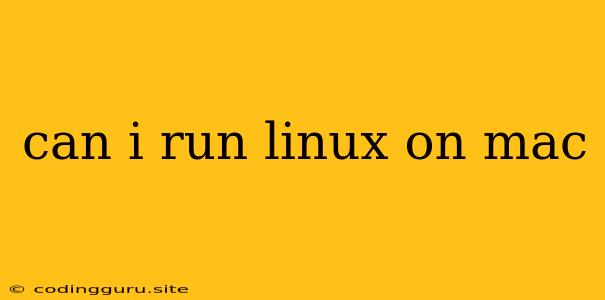Can I Run Linux on Mac?
You might be wondering if you can run Linux on your Mac. The answer is yes, you can! There are actually multiple ways to run Linux on a Mac. This gives you the flexibility to choose the best method for your needs and preferences.
Why Would You Want to Run Linux on Mac?
There are several reasons why you might want to run Linux on your Mac:
- Access to a broader range of software: Linux has a vast library of free and open-source software that you may not find on macOS.
- Experiment with different Linux distributions: You can try out different flavors of Linux, such as Ubuntu, Fedora, Debian, or CentOS, without having to install them on a separate computer.
- Improve your Linux skills: If you are learning Linux, running it on your Mac can provide a safe and convenient environment for practicing.
- Use Linux-specific tools and applications: If you need to use specific tools or applications that are only available on Linux, running it on your Mac provides a solution.
Methods for Running Linux on Mac
Here are the two primary methods for running Linux on your Mac:
1. Virtual Machines:
- What are Virtual Machines? Virtual machines (VMs) create a virtual environment on your Mac that can run an entire operating system, including Linux.
- How It Works: A program on your Mac, like VMware Fusion or Parallels Desktop, acts as a host for the Linux operating system. This allows you to run both macOS and Linux simultaneously, switching between them as needed.
- Advantages:
- Easy to set up and manage: Many virtual machine software programs come with pre-configured images of various Linux distributions, making installation a breeze.
- Isolation: Virtual machines isolate your Linux environment from your Mac's operating system, preventing any potential conflicts.
- Flexibility: You can easily create and manage multiple Linux virtual machines with different configurations.
- Disadvantages:
- Resource consumption: Running a virtual machine requires resources, including CPU, memory, and storage. This may lead to performance degradation on your Mac, especially if you run resource-intensive applications.
- Potential for slow performance: Running a Linux operating system within a virtual environment can be slower than native installation.
2. Boot Camp:
- What is Boot Camp? Boot Camp is a built-in utility in macOS that allows you to install a supported version of Windows (and, in some cases, Linux) alongside macOS on your Mac.
- How It Works: Boot Camp partitions your hard drive to create separate volumes for macOS and your chosen operating system, allowing you to boot into either one.
- Advantages:
- Native performance: Since Linux is running directly on your Mac's hardware, you get better performance compared to virtual machines.
- More efficient resource usage: Boot Camp uses fewer resources than a virtual machine, minimizing performance impact on your Mac.
- Disadvantages:
- Limited flexibility: You can only boot into one operating system at a time. To switch between macOS and Linux, you need to restart your Mac.
- Not as easy as virtual machines: Installing Linux on Boot Camp can be more complex than using a virtual machine.
Choosing the Right Method for You
When deciding between virtual machines and Boot Camp, consider your specific needs and priorities:
- Performance: If you prioritize performance, Boot Camp is generally the better choice.
- Flexibility: If you want to run multiple Linux distributions or switch between macOS and Linux quickly, a virtual machine is a better option.
- Ease of use: Virtual machines are typically easier to set up and manage.
- Resource consumption: Boot Camp uses fewer resources than virtual machines, so if your Mac has limited resources, Boot Camp might be the better choice.
Tips for Running Linux on Mac
Here are a few tips for a smooth experience running Linux on your Mac:
- Choose a Linux distribution that suits your needs: Research different Linux distributions and select one that meets your specific requirements.
- Install the necessary drivers: Some Linux distributions might require additional drivers for your Mac's hardware to function properly.
- Allocate sufficient resources: Ensure you allocate enough CPU, memory, and storage space to your Linux environment to ensure optimal performance.
- Consider using a lightweight desktop environment: If you're using a virtual machine, using a lightweight desktop environment like Xfce or LXDE can help reduce resource consumption.
Conclusion
Running Linux on your Mac can be a great way to experience the flexibility and power of this open-source operating system. Whether you choose virtual machines or Boot Camp, there are numerous options available to suit your needs and preferences. By following the tips and guidelines outlined in this article, you can enjoy a smooth and productive Linux experience on your Mac.
